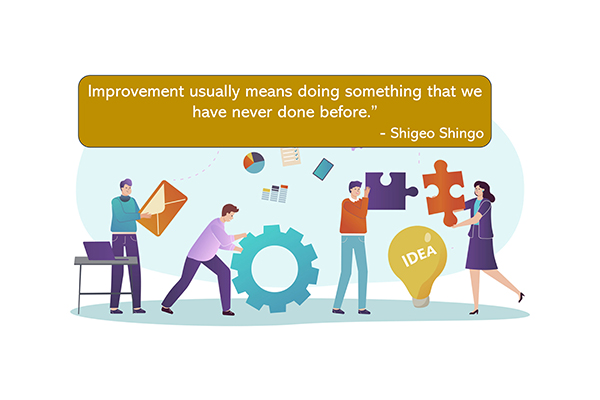“Improvement usually means doing something that we have never done before.”
– Shigeo Shingo
Fall is when many organizations finalize strategic plans and budgets for the coming year. What new ideas will you bring to your team and your organization? In Part Two of Leaders Driving Operational Excellence I will describe an approach to embrace three of the ten guiding principles of the Shingo Model from the Shingo Institute. The model focuses on the behavior of individuals and how to inspire teams which drives improved operational results.

Guiding Principles
- Focus on Process
- Create Constancy of Purpose
- Create Value for the Customer
Focus on Process
The foundational step in operational excellence is defining and documenting all aspects of your processes and workflows. Getting clarity on both your physical and digital workflows will enable leaders to identify gaps in procedures and documentation. Often an assessment of operational workflows will uncover any islands of knowledge and workarounds. “Islands of knowledge” are processes or pieces of equipment that only one or two people know how to operate optimally. Uncovering workarounds and manual steps allow leaders to define new processes and implement training which will improve throughput, lower costs, and reduce errors.
Best practices from highly productive print mail operations include:
- Documented procedures
- Defined metrics for people and processes
- Implemented ongoing cross-training
- Using checklists in daily operations
Constancy of Purpose
Constancy of purpose is a guiding principle that enables leaders to focus on communicating the “Why” for their team. With an organizational strategic plan and defined goals, teams in operations get clarity on why their organization exists and why their department exists. What we do in operations is very different than why we do it.
The strategy defines where the organization is going, and how it will get there. Operational leaders build upon the purpose to communicate and align their team actions. With constancy of purpose, teams are empowered to innovate, adapt, and take risks with greater confidence. Leaders committed to operational excellence create an environment based on trust – where employees are encouraged to challenge the status quo and contribute new ideas.
Create Value for the Customer
Your customers are relying on your team to bring them ideas that solve their business issues. Every department in your organization is managing significant changes in the current business and economic environment. Customers may have longstanding jobs that now need to change, and they may have new business challenges to respond to. Establishing value for customers starts with understanding your customers’ goals and business needs. Many departments may have new team members that do not fully understand the capabilities of your in-plant.
One example of creating value for your internal customers is conducting quarterly business reviews (QBRs). This is a best practice from commercial print and print service providers. These planning meetings are different than status reports. They are not about specific jobs. The purpose of a planning meeting is to foster the relationship between your print team and your customer’s key decision makers. The meeting will focus on discussing the business impact of the services the in-plant has provided so you can get clarity and alignment on the following topics:
- What results did print/mail/signage enable? What could be better?
- What new projects are being planned?
- What organizational goals are they focused on achieving?
- What went well?
- How can we be a resource?
- Their jobs matter, and they matter.
In my consulting role, I often hear when QBRs are initiated, the customers share issues and concerns that can easily be resolved by the print operations team. Customers may need better scheduling, a confirmation report with multiple tracking links, or assistance with design. By simply regularly asking what customers need, your team can foster better relationships with customers and instill confidence to support new jobs and programs. QBRs allow your team to demonstrate capabilities to meet your customers’ changing needs. Another result, the operations team is often inspired when they understand the organizational results from the jobs they produce.
Leaders who embrace process, purpose and customer value will encourage a culture that motivates teams to think creatively and offer new ideas. The future will be different, so we need to embrace change and continue to deliver value to our customers and organizations.
As you are looking to expand your strategies for operational excellence, there is much to learn from the The Shingo Model™ Guiding Principles. In part one of this article, I shared insights for the guiding principles: Respect Every Individual, Lead with Humility, Embrace Scientific Thinking, and Think Systemically.
As you continue to drive operational excellence, consider how you will inspire your team to do something they have never done.

Lois Ritarossi, CMC®, is the President of High Rock Strategies, a consulting firm focused on sales and marketing strategies, and business growth for firms in the print, mail and communication sectors. Lois brings her clients a cross functional skill set and strategic thinking with disciplines in business strategy, sales process, sales training, marketing, software implementation, inkjet transformation and workflow optimization. Lois has enabled clients to successfully launch new products and services with integrated sales and marketing strategies, and enabled sales teams to effectively win new business. You can reach Lois at https://www.highrockstrategies.com/ or Lritarossi@highrockstrategies.com
